Your Call?
Which is the strongest of today’s five featured images? Which is the weakest of today’s five featured images? Why for each?
Used Gear Pipeline
I have a Canon EF 600mm f/4L IS II lens coming up for sale. If you might be interested in purchasing it, shoot me an e-mail.
On a related note, I was pleased to learn that my third Sony a-1 sold within hours of being listed yesterday. Folks know that I price my stuff to sell quickly.
What’s Up?
Kevin has been hard at working repairing the two badly damaged blinds. The high winds continue, with gusts over 40mph today. We should be good to get back to work and try for Sharp-tailed Grouse on Saturday.
Today is Thursday 18 April 2024. We will be visiting a friend of Kevin’s in Bismarck this afternoon. She likes birds and has a kit camera but is physically limited. I’ve heard that she is a great cook and am looking forward to dinner. Whatever you are and whatever you are doing, I hope that you too choose to have fun.
It’s Not Too Late
It’s not too late to join me on the 2024 May DeSoto IPT, coming up in less than three weeks. May is a wonderful time to visit this always productive location. Info below. Call 863-221-2372 or shoot me an e-mail if you have any questions.
|
|
|
Fort DeSoto in spring is rife with tame birds, many in full breeding plumage. Click on the composite to enjoy a larger version. Clockwise from upper left around to center: Laughing Gull landing on head of Brown Pelican, Laughing Gull in flight, Reddish Egret sunrise silhouette, Great Blue Heron with needlefish, Yellow-crowned Night Heron with ghost crab, Roseate Spoonbill, Sanderling in breeding plumage, and white morph Reddish Egret in glorious breeding plumage. |
The 2024 Spring Fort DeSoto Instructional Photo Tour (IPT)
The Spring Fort DeSoto IPT: Wednesday 8 May through the morning session on SAT 11 May 2023. 3 1/2 Days: $1899.00 includes three working brunches. Limit six photographers. Openings: 4.
Fort DeSoto, located just south of St. Petersburg, FL, is a mecca for terns and gulls, wading birds, and shorebirds in springtime. Though DeSoto can be great any day of the year, spring is my very favorite time to be there as many of the birds will be in full breeding plumage. Simply put, DeSoto is the new Ding Darling. Migrant shorebirds are in abundance, and many are exceedingly tame. We should have great chances on Royal and Sandwich Terns and both white- and dark-morph Reddish Egrets. Great Egret, Snowy Egret, Great Blue Heron, Tricolored Heron, and White Ibis are easy as well and we will almost surely come up with a tame Yellow-crowned Night-Heron or two along with some American Oystercatchers. We will enjoy lots of great flight photography, especially with the Brown Pelicans.
|
|
|
Again, Fort DeSoto in spring is rife with tame birds, most in breeding plumage. Click on the composite to enjoy a larger version. Clockwise from upper left around to center: Laughing Gull in flight, Yellow-crowned Night-Heron, Sandwich Terns copulating, Roseate Spoonbill, Great Egret with reflection, breeding plumage Short-billed Dowitcher, American Oystercatcher, Royal Tern, white morph Reddish Egret, and Snowy Egret in marsh. |
In Addition!
We should also get to photograph a variety of other shorebirds including Black-bellied, Semipalmated, Wilson’s, Snowy, and Piping Plovers, Willet, Dunlin, Short-billed Dowitcher, Marbled Godwit, and most especially, Red Knot. On the May trip, many of the shorebirds will be in their handsome breeding plumages. In spring the T-shaped peninsula and the newly formed sandbar, Outback Key, are literally packed with avian treasures.
With just a bit of luck, we may get to photograph one of Florida’s most desirable species: Roseate Spoonbill. And we will surely get to do some Brown Pelican flight photography. With luck, they will have Laughing Gulls landing on their heads. And though not guaranteed, Wood Stork might well be expected. And we will be on the lookout for a migrant passerine fallout in the event of a thunderstorm or two. I almost forgot to mention — Laughing Gulls in breeding plumage are to die for!
You do NOT need a fast super-telephoto lens to do this trip!
|
|
|
Yes, Fort DeSoto in spring is rife with tame birds, most in breeding plumage. Click on the composite to enjoy a larger version. Clockwise from upper left around to center: breeding plumage Dunlin, dark morph Reddish Egret displaying, Laughing Gull vertical front-end portrait, Laughing Gull with prey item, landing on head of Brown Pelican, breeding plumage Royal Tern displaying, Royal Terns — pre-copulatory stance, Laughing Gulls copulating, Laughing Gull head portrait, breeding plumage Sandwich Tern with fish, and a rare treat, a breeding plumage White-rumped Sandpiper. |
What You Will Learn on a DeSoto IPT
- 1- The basics and fine points of digital exposure; how to get the right exposure every time after making a single test exposure (or before if you are using SONY gear).
- 2- How and why to work in Manual mode (even if you’re scared of it).
- 3- How to approach free and wild birds without disturbing them.
- 4- Lots about bird behavior and how to use that knowledge to help you create better images.
- 5- To age and identify many species of shorebirds including various sandpipers, plovers, dowitchers, and possibly yellowlegs.
- 6- To spot good situations and to choose the best perspective.
- 7- To see, evaluate, and understand the light.
- 8- To design pleasing images by mastering your camera’s AF system.
- 9- And perhaps most importantly, to evaluate wind and sky conditions and understand how they affect bird photography.
- 10- More than you could ever imagine.
|
|
|
You got it by now! Fort DeSoto in spring is rife with tame birds, most in breeding plumage. Click on the composite to enjoy a larger version. Clockwise from upper left around to center: Roseate Spoonbill, immature Brown Pelican in flight, the heron/egret hybrid, American Oystercatcher feeding, immature Royal Tern on railing, Great Egret morning silhouette, Black Skimmer in surf, and underside head portrait of Great Blue Heron. |
The Details
Morning sessions will run about two and one-half hours; afternoon sessions about two. There is never a set schedule on an IPT — we adapt to the conditions. On cloudy mornings with the right wind, we may opt to photograph till 11:30 or so and skip the afternoon session. That especially when the afternoon weather is looking iffy. We may opt to visit a great North Tampa rookery if conditions warrant that.
There will be a Photoshop/Image Review session during and after brunch (included) each of the three full days. That will be followed by Instructor Nap Time. This IPT will run with only a single registrant as I do not like disappointing anyone. The best airport is Tampa (TPA). Once you register, you will receive an e-mail with lodging information. Do know that it is always best if IPT folks stay in the same general area (rather than at home or at a friend’s place a good distance away). For folks who register soon, the is an excellent chance that we can share an AirBnb to reduce lodging and meal costs and maximize your learning opportunities.
Folks attending this IPT will be out in the field as early as possible and stay out late to take advantage of sunset colors. Doing so will often present unique photographic opportunities, opportunities that will be missed by those who need their beauty rest and those who need to get home for a proper dinner. I really love it when I am leaving the beach at 9:30am on a sunny morning after a great session just as a carful or two of well-rested photographers are arriving … We will be getting wet.
Your non-refundable $599 deposit is due now. Credit cards are OK for that. You can register by calling Jim or Jennifer during weekday business hours at 863-692-0906 with a credit card in hand. Once you leave a deposit, you will receive an e-mail with your balance statement and instructions for sending your balance check three months before the trip begins. If you wish to pay in full right off the bat, you can make your check out to BIRDS AS ART and send it via US mail here: BIRDS AS ART, PO BOX 7245, Indian Lake Estates, FL 33855. You will receive a confirmation e-mail with detailed instructions, and clothing and gear advice two months before the trip. Please shoot me an e-mail if you plan to register or if you have any questions.
IPT veterans and couples or friends signing up together may e-mail for discount information. If you have any questions, or are good to go for one of these great trips, please let me know via e-mail or give me a call on my cell phone at 863-221-2372 for more info.
Typos
With all blog posts, feel free to e-mail or to leave a comment regarding any typos or errors.
|
|
|
This image was created on 9 MAY 2023 on a DeSoto IPT. While seated on damp sand, I used the toe-pod technique with the handheld the Sony FE 400mm f/2.8 GM OSS lens Tracking: Zone/AF-C with Bird Face/Eye detection enabled performed to perfection. Be sure to click on the image to enjoy a high-res version. Image #1: Little Blue Heron with tiny baitfish |
“Pied” Little Blue Heron
At about one year old, juvenile Little Blue Herons (pure dusky white before then) begin to molt in some blue adult feathers and assume a “pied” look. They are quite handsome at this stage. As with the white juvenile, note the thicker bill (as compared to Snowy Egret) that is light blue at the base with a dusky tip and the greenish yellow legs. This is a plumage stage not a phase or a morph. There are usually one or two to be found on a walk at DeSoto in May.
|
|
|
This image was created on 9 MAY 2023 on a DeSoto IPT. While seated on damp sand, I used the toe-pod technique with the handheld Sony FE 600mm f/4 GM OSS lens and The One, the Sony Alpha 1 Mirrorless digital camera. ISO 500. Exposure was determined via Zebras with ISO on the rear dial: 1/2500 sec. at f/5.6 (stopped down one stop — don’t ask me why). AWB at 6:33:10am on a sunny afternoon. Tracking: Zone/AF-C was active at the moment of exposure and performed perfectly. Be sure to click on the image to enjoy the larger version. Image #2: Snowy Egret — adult with foot raised |
Adult Snowy Egret
Adult Snowy Egrets have legs that are totally black front and back. The back of the legs of a one-year-old snowy are yellow. The prize in April and May is an adult at the peak of breeding plumage that features bright, cherry-red lores. The lores is the skin that covers the area in front the eye to the base of the upper mandible. The brightest colors are present only on birds that are actively breeding and lasts only a very few days before beginning to fade to pink.
|
|
|
This image was created on 11 MAY 2023 on a DeSoto IPT. Seated on damp sand I used the lowered, Robus RC-5558 Vantage Series 3 Carbon Fiber Tripod/Levered-Clamp FlexShooter Pro-mounted Sony FE 600mm f/4 GM OSS lens with the Sony FE 1.4x Teleconverter, and The One, the Sony Alpha 1 Mirrorless Digital Camera.. ISO 1000. The exposure was determined by Zebras with ISO on the rear wheel: 1/2500 second at f/6.3 (stopped down 1/3 stop — don’t ask me why) in Manual mode. RawDigger showed that the raw file brightness was perfect. AWB at 7:47:12am on sunny morning. Tracking: Zone/AF-C with Bird-Eye/Face Detection performed perfectly. Click on the image to enjoy the high-res version. Image #3: Snowy Plover — male flapping after bath (band removed) |
Snowy Plover
In April and May of 2023 I saw more Snowy Plovers than ever before at DeSoto, often a dozen or more on some mornings. Several pairs bred successfully on Outback Key. This guy landed right in front of me and took a bath in a rising tidal pool along with dozens of other shorebirds.
|
|
|
This image was created on 11 MAY 2023 on a DeSoto IPT. Crouching a bit, I used the handheld Sony FE 200-600mm f/5.6-6.3 G OSS lens (at 600mm) and The One, the Sony Alpha 1 Mirrorless digital camera. ) The exposure was determined using Zebra technology with ISO on the Thumb Dial. ISO 800. 1/1250 second at f/10 (stopped down about 1 1/3 stops) in Manual Mode. AWB at 9:51:15am on a sunny morning. RawDigger showed the raw file brightness to be perfect. Tracking: Spot Expand Spot/AF-C with Bird Face/Eye Detection performed perfectly. Be sure to click on the image to enjoy a high-res version. Image #4: Ruddy Turnstone in breeding plumage on jetty |
Photographing Late on a Sunny Morning
Two hours after sunrise the light is cooler and harsher than it was earlier. The trick to making successful images is to work tight and get as close to right on sun angle as possible. The sun in this image is coming from high right. Because I was fairly close to a large in the frame subject I opted to stop down in an effort to render the whole bird sharp. The danger was bringing up too much background detail (by stopping down) but the rock behind the bird was distant enough to minimize that problem.
|
|
|
This image was created on 11 MAY 2023 on a DeSoto IPT. Crouching just a bit, I used the handheld Sony FE 200-600mm f/5.6-6.3 G OSS lens (at 600mm) and The One, the Sony Alpha 1 Mirrorless digital camera. ) The exposure was determined using Zebra technology with ISO on the Thumb Dial. ISO 1000. 1/2500 second at f/6.3 (wide open) in Manual Mode. AWB at 6:03:29pm on a sunny afternoon. RawDigger showed the raw file brightness to be perfect. Tracking: Zone/AF-C with Bird Face/Eye Detection performed perfectly. Be sure to click on the image to enjoy a high-res version. Image #5: Whimbrel taking flight |
Topaz Sharpen AI for Motion Blur
1/2500 second combined with a less than ideal panning rate (aka operator error) led to lots of motion blur on this otherwise very nice image. In Topaz Sharpen AI I painted a mask (thanks to Commander Jon Hoiles for that lesson), checked both AUTO boxes, and hit APPLY. The plug-in suggested Normal but the motion blur was still quite evident. So I over-rode the system and went with Motion Blur and applied that on a separate layer. Working large, I noted that the sharpening effect was over-done so I reduced the Opacity of the Sharpen AI layer to 80%. The result was quite excellent and the image is fine for web presentation.
Typos
With all blog posts, feel free to e-mail or to leave a comment regarding any typos or errors.

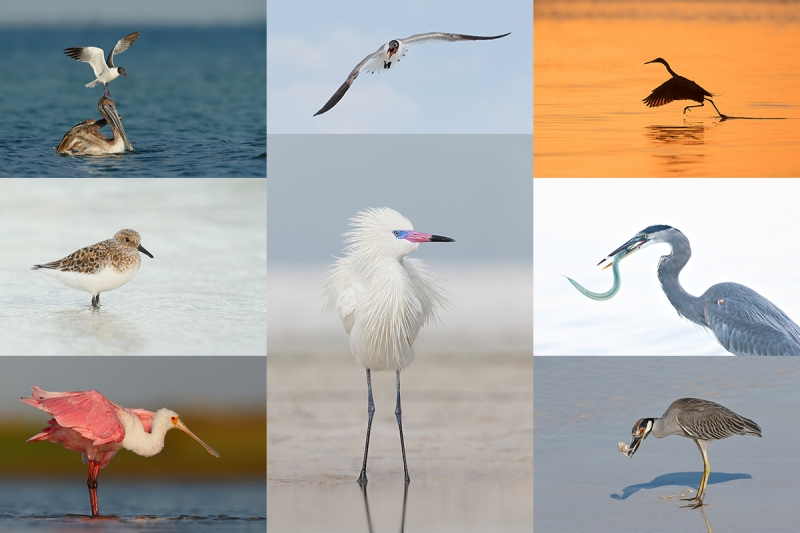
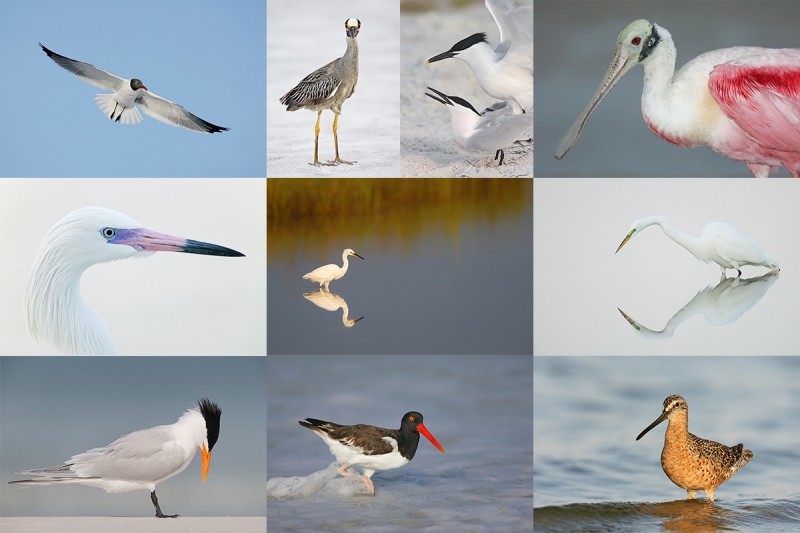
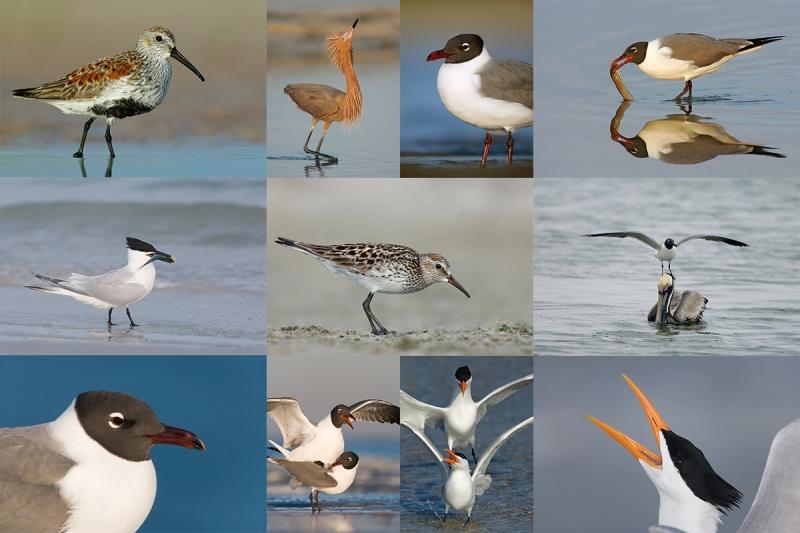
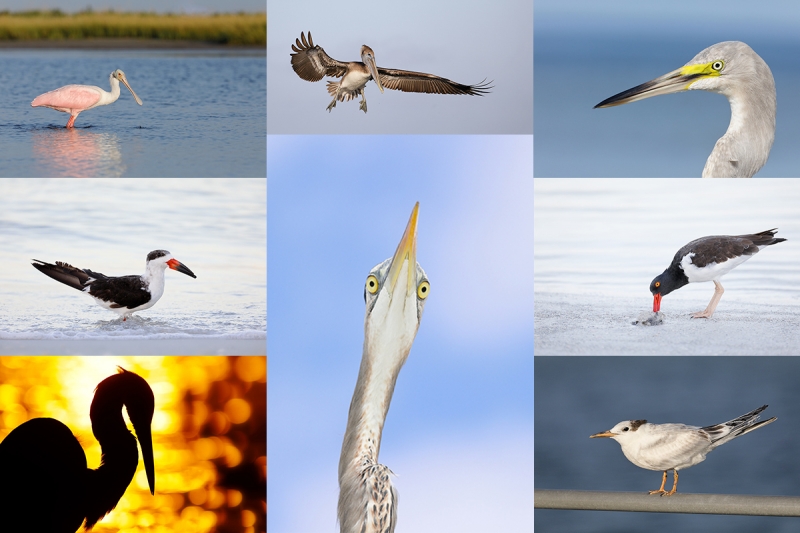
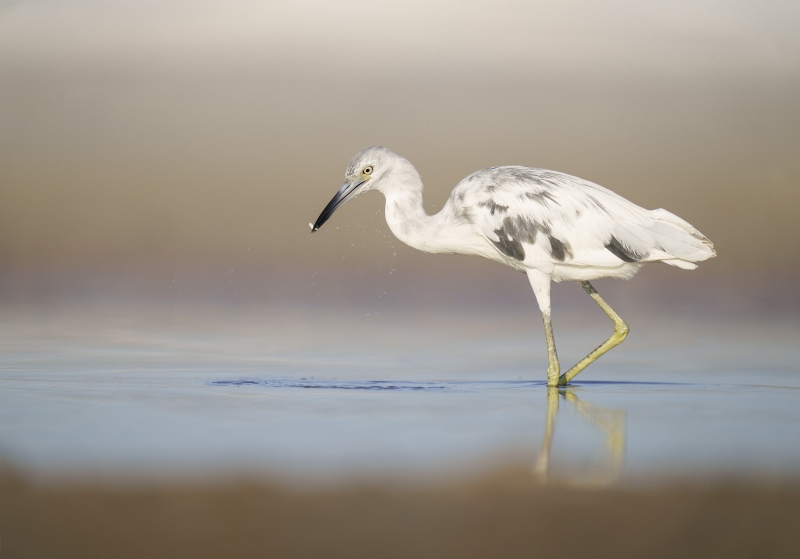
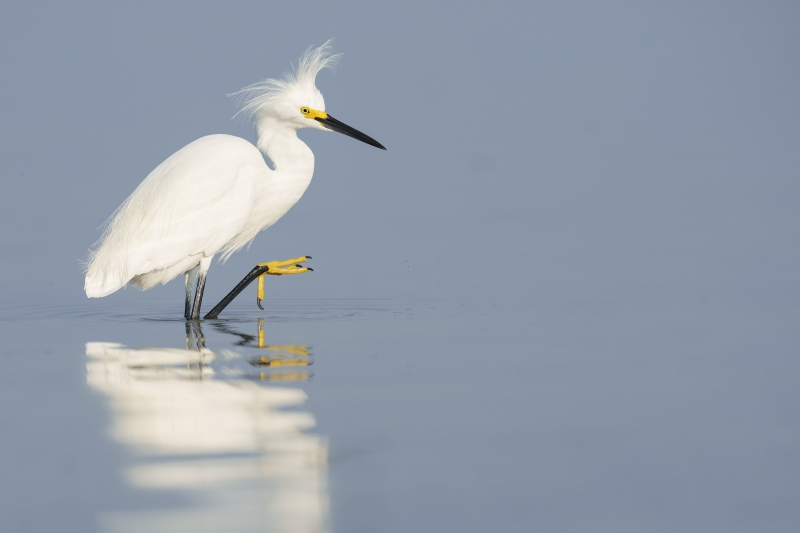
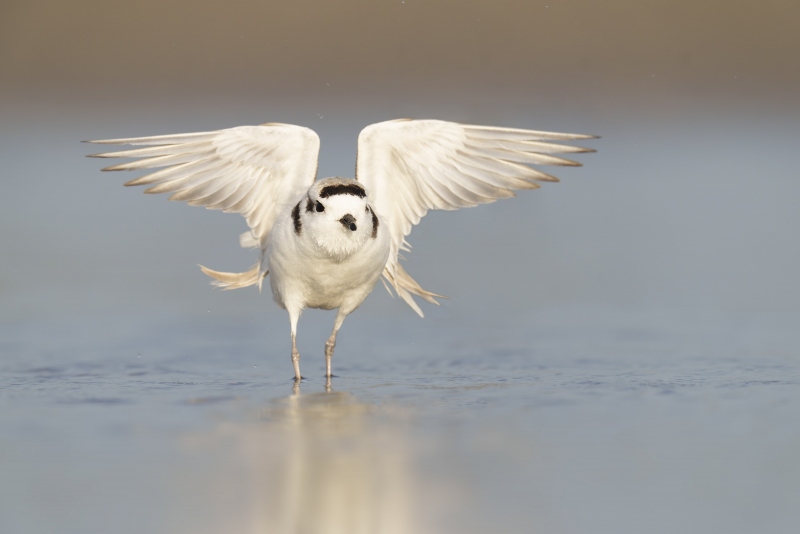
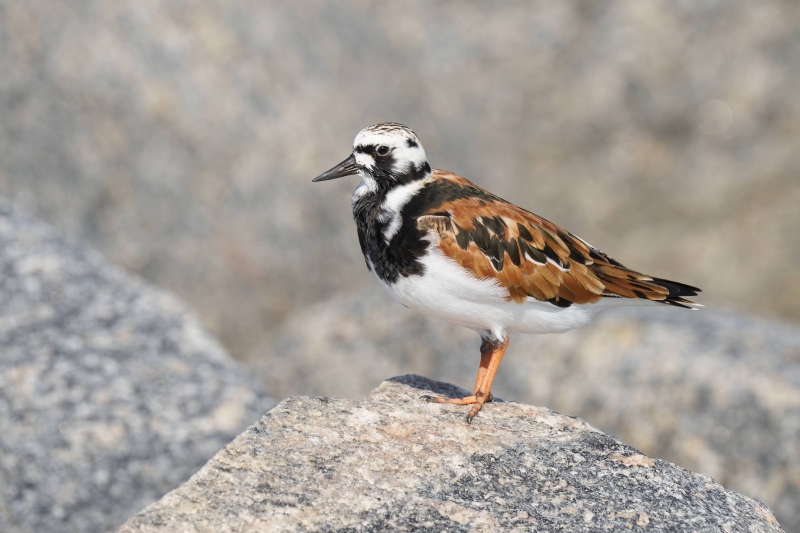
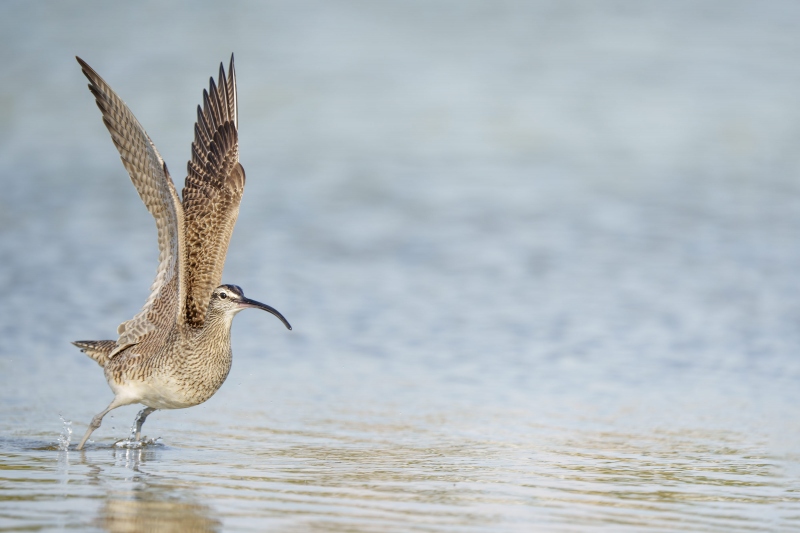













I like the 2nd image and the last image, with my absolute favorite being that of the Snowy Egret (#2). The lift of the foot, the disarray of the feathers on the head, the reflection that balances the composition…love it. I would have chosen the last image but I wish there had been a bit more space to the left…but I love the wing position, the hint of a splash around its feet. Both are strong images, Artie.
My favorite is the little blue heron. The smooth water, the layers of colors in the background, the baitfish, the droplets of water – all add to the quality of the image. My least favorite is the Whimbrel. The water is not as smooth and the background colors are not as interesting, the legs of the bird are slightly out of focus.
Thanks, Moe. That is what happens when you stand 🙁
with love, artie
that’s correct, Artie. When you stand, the bird gets scared and flies away
Sometimes 🙂
a
I like the Snowy Plover (#3). The wing position makes it look angelic. Nice, clean, background with goldish hue on top.
My favorite is #5. I very much like the more unusual framing with the bird on the far left, filling up that third of the frame and leaving lots of space on the right. The sand filtered by the water grounds the image and repeats the tone of the bird, which beautifully contrasts against the mottled blue/gray background.
#1 is my favorite for a variety of reasons including, color, composition, light, and interest.
My favorite is the bad-hair snowy egret with the raised foot and a facial expression that seems to be a shrug.